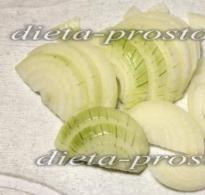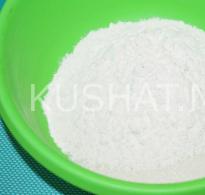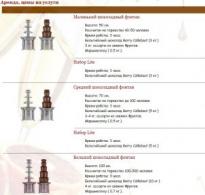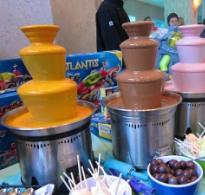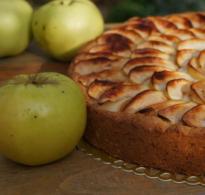Defects in dairy products. Milk defects
MINISTRY OF AGRICULTURE VGSHA DEPARTMENT OF COMMODITY AND VETERINARY AND SANITARY EXPERTISE SUMMARY TOPIC: “Changes in the quality of milk during storage. Milk defects. Contents 1. Defects of taste….2. Defects of a smell … 3. Consistency defects…4. Color defects… 5. Measures to prevent the occurrence of defects……… 7 Milk should be a homogeneous liquid without sediment.
High-fat milk should not have cream sludge. The taste and smell must be clean, free of foreign tastes and smells not characteristic of fresh milk. The color is white, with a slightly yellowish tint, for melted - with a creamy tint, for non-greasy - with a slightly bluish tint. DEFECTS OF MILK. All diseases or defects of milk can depend on two causes: internal, depending on the disease state of the animal itself, and external, which includes infection by microorganisms,
incorrect milk processing technology, violation of the regimes and terms of its storage. * DEFECTS OF TASTE easily arise under the influence of bacterial processes. So: - sour taste appears as a result of the activity of lactic acid bacteria; - bitter - during long-term storage of milk at temperatures below 10 degrees as a result of the development of putrefactive microorganisms; - milk acquires a soapy taste during long-term storage, when, as a result of the development of putrefactive microflora
alkaline substances are formed that wash the fat; - unpleasant aftertastes in milk can appear from feeding animals fresh nettle, sedge, cabbage, garlic, turnip, etc. - salty taste is formed in some diseases of the udder of animals. As a result of the vital activity of lactic acid bacteria or E. coli, milk acquires a sour taste. Hot milk. And in this case, milk immediately after milking is quite benign, but after a short
time the risen cream gets a bitter taste and becomes covered with yellowish spots. The bitter taste in milk is due to the activity of putrefactive peptonic bacteria, and can also be caused by the presence of wormwood in the feed. Rancid, or lipolytic, taste of milk, the most common among taste defects, is a consequence of the hydrolysis of milk fat by lipases at low storage temperatures. It is more common in the milk of old milk cows. “Responsible” for the occurrence of this defect is oil,
caproic, caprylic, capric and lauric acids. Lipolytic rancidity in milk is very stable. A rancid taste also appears in the milk of the last days of lactation. During storage, an oxidized, acrid astringent taste is sometimes observed, which is felt by the root of the tongue. This defect is caused by the oxidation of unsaturated fatty acids.
As a result, unsaturated (with one or two double bonds) aldehydes and ketones are formed. The occurrence of this defect in milk is facilitated by the presence of copper, iron, selenium ions. Under the influence of sunlight (when milk is stored in the light), milk acquires a greasy, oleic taste due to the formation of hydroxy acids from unsaturated fatty acids as a result of interaction with peroxides, as well as the formation of saturated acids under the influence of atomic oxygen.
In the presence of traces of copper at elevated temperatures, pH 6.6-6.7, unpleasant metallic and fishy aftertastes may appear. Milk acquires a metallic taste as a result of the interaction of lactic acid with the metal of the container. Under the action of light, oxygen, vitamins B2 (riboflavin) and C, as well as copper, methionine, which is part of whey proteins, is oxidized to methional, which gives the milk a sweetish taste reminiscent of a turnip or cabbage, the so-called sunny taste.
The end products of methionine breakdown can impart a burnt, malty, or starchy flavor to milk. Malty smell and taste are also formed as a result of the enzymatic breakdown of amino acids with the formation of aldehydes and ketones. A smoky taste and smell is possible in sterilized milk and packages if the paper is burned when gluing the transverse seams of the package. As a result of proteolysis of protein substances by putrefactive bacteria and E. coli, putrefactive,
cheesy and musty flavors. Unpleasant specific flavors can appear from the presence of nettle, garlic, onion, turnip, radish, field mustard, etc. in the diet of animals. . Of the discrediting odors, the most famous are bread, rotten, garlic, cheese, etc. *
DEFECTS OF THE CONSISTENCY are formed as a result of the activity of certain microorganisms. DENSE CONSISTENCY milk acquires due to the activity of lactic acid bacteria, mucus or viscous - under the action of mucus-forming microorganisms. As a result of the development of yeast, E. coli and butyric acid bacteria, FOAM is formed in milk. If rennet-producing bacteria enter, the milk coagulates during heating even
with low acidity. When freezing, the colloidal state of milk is disturbed, as a result of which it stratifies - desalinated ice forms on the walls of the container, fat floats to the surface, and protein concentrates in the central and lower parts. When thawed, flakes and lumps form in milk. The taste becomes watery and sweet. Thick or slimy milk. This is milk, which has the property of stretching in threads and acquiring this vice after a more or less short
period of time after milking. If normal milk is poured into a vessel in which there was diseased milk, then it will soon acquire the same properties. The mucus (viscosity) of milk is determined by the development of mucus-forming races of lactic acid and putrefactive microbes in it. It is observed during long-term storage of milk at low temperatures, when the normal lactic acid process is delayed, and in some forms of mastitis. Such milk is subject to technical disposal and for food purposes.
not used. In Sweden and Finland, viscous milk is sometimes artificially prepared using the plant Pinguicula vulg. for the purpose of its longer storage, and then it is quite harmless. * DEFECTS OF COLOR appear under the influence of pigment bacteria that cause redness, blue and yellowing of milk. The reason for the change in color may also be the presence of a certain amount of blood that has entered the milk during milking due to the diseased state of the animal.
Blue milk. This phenomenon consists in the fact that freshly milked milk, which apparently does not differ from healthy milk, after some time (from 6 to 60 hours) is covered with separate blue spots, and subsequently the entire thickness of the cream is sometimes in the form of a continuous blue veil. After removing this layer of "sick" cream, the blue color appears again, and the milk acquires a nasty smell; the appearance of blue is due to the presence of special fungi from the genus
Penicillium, which are themselves colorless, but contribute to the decomposition of casein, which forms aniline blue, which turns cream blue. Such milk therefore has highly toxic properties. Since the cause of this disease can be not only a disorder of the digestive organs of a given animal, but also an infection, then, in addition to treating a sick cow, it is also necessary to use dairy disinfection, best by fumigating with sulfur and washing walls and dishes with water and bleach.
Measures to prevent the occurrence of defects in milk. To prevent the appearance of defects in milk, first of all, it is necessary to strictly observe the sanitary and hygienic regime for obtaining, storing and transporting milk. It is necessary to control the quality of feed and feed rations, temperature regimes of feed storage. Frozen, moldy and heavily contaminated feed should not be used.
To eliminate fodder odors and taste, milk is deodorized, while being freed from absorbed chemical compounds that are not characteristic of milk. It is necessary to avoid storing milk in the light, as well as in untinned containers, try to minimize its mixing. Pasteurized cow's milk should be stored at a temperature of 0 to 36°C for no more than 36 hours from the end of the technological process; sterilized milk at a temperature of 0 to 10 ° C - 6 months;
in tetra-brik-aseptic package - 4 months.
A change in the quality and even spoilage of drinking milk can occur under the influence of many factors, and therefore proceed in different ways. With full observance of the modes and parameters of the technology, as well as the established storage conditions (duration, temperature), as a rule, all of them retain the quality within the norm of standard requirements during the warranty period of storage.
color flaws
brownish tint
Cause. Melanoidin reaction products during long-term storage of baked and sterilized milk.
. Observe the temperature and duration of languishing, milk sterilization, and avoid prolonged storage of the product.
Pronounced yellow, pink-red shades
Cause.
Prevention and mitigation measures
Consistency defects
Viscous sand
Cause. Zootechnical factors, violation of milking rules and high bacterial contamination of raw milk.
Prevention and mitigation measures. Do not mix colostrum and old milk with normal milk. Comply with the conditions for obtaining, storing and transporting milk.
Noticeable fat sludge
Cause. Insufficient homogenization efficiency.
Prevention and mitigation measures. Maintain the required homogenization pressure in accordance with the technological instruction (TI).
flaky
Cause. The use of raw materials - milk with low thermal stability. The development of Bacillus subtilis, B. circulans, B. coagulans and non-spore-forming bacteria as a result of violation of the regimes: sterilization, asepsis, washing and disinfection of equipment (tanks, pipelines) and storage.
Prevention and mitigation measures. Select raw materials for thermal stability. Observe the modes of sterilization, washing and disinfection of equipment (tanks and pipelines), as well as the storage conditions of the product.
Presence of rendered fat
Cause. Denaturation of protein shells of fat globules and their partial destruction
Prevention and mitigation measures. Observe the parameters of languishing in the production of baked milk.
Thickening (gelling), noticeable sediment in sterilized milk
Cause. Enzymatic and physico-chemical processes during long-term storage of the product.
Prevention and mitigation measures. Do not use raw materials - long-term storage milk. Do not allow long-term storage of the finished product. Reduce product storage temperature
Sediment of non-dispersed particles of milk powder, watery
Cause. Unsatisfactory quality of milk powder. Non-compliance with the parameters of the dissolution of milk powder, lack of homogenization.
Prevention and mitigation measures. Use good quality milk powder. Observe the parameters of the dissolution of milk powder in accordance with TI. Carry out homogenization.
Defects of smell, taste and aroma
Forage, unclean
Cause. Zootechnical factors, violation of the conditions for obtaining and storing milk.
Prevention and mitigation measures. Comply with the conditions for obtaining, storing and transporting milk.
bitter taste
Cause. The development of secondary microflora with high lipolytic and proteolytic activity during long-term storage after unsatisfactory washing and disinfection of equipment. Residues of detergents and disinfectants.
Failure to comply with the rules for feeding and keeping cows, the conditions for storing milk on the farm. Long-term storage of milk in packages, including non-standard materials.
Lowering the milk sterilization temperature; insufficient sterilization efficiency of milk and packaging material.
Specific (drugs, petroleum products)
Cause. Violation of the rules for the treatment of cows and the storage of milk.
Comply with the conditions for obtaining, storing and transporting milk.
Soapy, soda flavors
Cause. Contact with detergents and disinfectants. Intentional neutralization with soda to reduce the acidity of milk.
Prevention and reduction measures. Thoroughly rinse the equipment (pipelines and containers), do not allow detergents and disinfectants to enter the product. Do not allow falsification of milk with soda.
Slightly salty taste
Cause. Ingress of brine during cooling of the product.
Prevention and reduction measures. Ensure that no brine enters the product during cooling.
Watery, incomplete taste
Cause. Mixing the product with water residues in tanks and pipelines. Malfunction of the automatic temperature difference control system during preheating, steam sterilization and in the vacuum chamber. For reconstituted milk - the use of low-quality milk powder. No homogenization.
Prevention and reduction measures. Monitor the complete outflow of water from tanks, pipelines when starting or temporarily stopping the line. Reject the first packages with the product. Maintain the preheat temperature before sterilization 1 to 2 °C lower than in the vacuum chamber.
Use good quality milk powder. Be sure to homogenize. Use fragrances.
Smoky
Cause. The ingress of milk on hot surfaces (200 - 250) ° C in Tetra-Pak machines due to a pressure drop of the product during its uneven supply from an aseptic tank.
Prevention and reduction measures. Monitor the correct operation of the pressure regulators in the aseptic tank and ensure a uniform supply of product to the machines.
Pronounced smell and taste of pasteurization, repasteurization, steel, cabbage
Cause. High temperature of heat treatment of milk (130 - 150) ° C and long exposure (more than 5 s).
Prevention and reduction measures. Observe the sterilization regimen.
Caramelized, burnt
Cause. Exceeding the parameters of soaking, UHT treatment and sterilization in bottles. Reduced thermal stability of raw materials. Burning of the product on the surface of the heat exchanger.
Prevention and reduction measures. Use heat-resistant raw materials. Observe the parameters of languor. Make sure that the heat exchangers operate no longer than it is stipulated in the instructions for their maintenance.
Lipolytic, rancid
Cause. Conducting homogenization after pasteurization.
Prevention and reduction measures. Homogenize milk prior to pasteurization. Do not mix pasteurized and homogenized milk with raw milk.
Fruity, malty flavors
Cause. Failure to comply with the rules for feeding and keeping cows, the conditions for obtaining, primary processing and storage of milk on farms.
Prevention and reduction measures. Observe the rules for feeding cows.
Avoid strong and prolonged mixing and long-term storage of raw materials. Thoroughly wash and disinfect equipment.
Sour taste
Cause. Secondary contamination during storage and bottling of pasteurized milk or in the aseptic part of the sterilizer as a result of depressurization of equipment sections, violation of asepsis of bottling or tightness of packaging; poor-quality washing and disinfection of equipment.
Prevention and reduction measures. Observe the technological and sanitary regimes of production.
Outsiders, unpleasant
Cause. Enzymatic oxidation of amino acids to keto- and hydroxycarboxylic acids, aldehydes, amines, amyl ketones, ammonia, CO2 during long-term storage of milk.
Prevention and reduction measures. Systematically check the condition of the surface of the plates, change the broken seals in a timely manner and regulate the operation of the return valve of the pasteurization and cooling units. Avoid prolonged storage of the product.
Phenolic
Cause. Bacillus circulans spore contamination in sterilized milk bottled in glass bottles.
Prevention and reduction measures. Hands should be disinfected when lubricating filling machines
Musty, stale
Cause. Accumulation of products of lipid peroxidation reactions during long-term storage.
Prevention and reduction measures. Store pasteurized milk before bottling no more than 6 hours at (6 ± 2) °C. Observe the established duration and temperature of storage from the end of the technological process.
Taste of packaging material
Cause. For long-term storage in packages made of non-standard packaging materials
Prevention and reduction measures.
Do not use packaging materials that have odors and carry out the necessary control. Do not store the product in the packaging for more than a certain period
Oxidized, metal- and light-induced oxidized
Cause. Peroxidation of lipids, vitamins, catalyzed by metals and light exposure
Prevention and reduction measures. Minimize the saturation of milk with air. Avoid contamination of milk with traces of heavy metals, especially copper and iron. Use natural antioxidants. Avoid strong and prolonged shaking. Eliminate the influence of direct short-wave radiation. Properly select and use light- and gas-tight packaging materials. Comply with the rules for transporting milk and technological parameters of production
"Sunny" taste
Cause. Non-enzymatic oxidation of sulfur-containing and some other amino acids as a result of light exposure
Prevention and reduction measures. When packaging products in glass bottles, ensure the least exposure to light during transportation and on retail shelves
For reconstituted milk - rancid, greasy, slightly salty, metallic flavors
Cause. Unsatisfactory quality of milk powder. Excessive content in the water used to dissolve milk powder, mineral salts. Use of raw materials from poorly tinned metal containers.
Prevention and reduction measures. Use good quality milk powder. Monitor the quality of the water used to dissolve milk powder. Use standard milk storage containers
Defects can be characteristic of freshly milked milk, as well as occur during storage as a result of the vital activity of microorganisms. This significantly changes the composition and organoleptic properties of milk.
Taste and odor defects.
Sour taste (high acidity) is due to the activity of lactic acid bacteria in violation of the modes and terms of storage of milk.
The rancid taste is manifested by the hydrolysis of fat by the action of milk lipase or lipase of microorganisms at low storage temperatures. The defect is often detected when old milk containing a significant amount of lipase is ingested.
Bitter taste occurs when proteins break down to form peptones, which have a bitter taste. The decomposition of the protein is due to the action of peptonizing bacteria that enter and develop in milk in case of violations of the sanitary and hygienic regime for its production, storage and transportation at temperatures below 10 ° C; occurs more frequently in reconstituted milk.
A bitter taste also occurs when there are significant amounts of bitter plants in the feed.
The oxidized taste is also called oleic, greasy, metallic, or sunny. It is caused by the accumulation of fat oxidation products in milk: hydroxy acids, aldehydes, ketones. The reasons for the appearance of this defect are the action of sunlight, ultraviolet rays, air, high temperature, as well as the storage of milk in untinned iron and copper dishes, since metals, especially copper, contribute to the oxidation of milk fat.
A salty taste appears due to a change in the salt composition of milk in certain diseases of the animal.
Feed tastes and odors arise from the transition from feed to milk of characteristic flavoring substances and essential oils.
For this reason, various flavors and odors may appear in milk: wormwood, garlic-onion, rare, silage, cabbage, etc.
Extraneous tastes and odors appear as a result of the absorption of volatile compounds (hydrocarbons, esters, ketones, etc.) by milk. Therefore, joint storage and transportation of milk with strong-smelling products is not allowed.
Milk that has the indicated defects in taste and smell is not allowed to be sold as drinking milk intended for direct consumption; it is sent for processing.
Color defects. Milk can take on red, pinkish, blue, blue or yellow hues. Changes in the natural color of milk are associated with the development of pigment-forming bacteria in it, some yeasts and ingestion of blood from a damaged udder, eating herbs with pigments by animals, with certain diseases (with mastitis and tuberculosis - bluish, with foot-and-mouth disease - yellow), mixing with colostrum (yellow) , storage of milk in zinc dishes (bluish).
Consistency defects. Sometimes milk acquires a slimy (viscous), curdled or frothy texture. This is due to the activity of various microorganisms in violation of the modes and periods of storage of milk.
Defects of milk - deviations of organoleptic indicators, chemical composition, packaging and labeling of milk from the indicators provided for by the standard, arising from the use of poor-quality raw materials, violations of technological regimes and storage.
There are defects in taste and smell, technological properties, consistency and color.
All diseases, defects or defects in milk can depend on two causes: internal, depending on the disease state of the animal itself, and external, which include infection with microorganisms, improper milk processing technology, violation of the regimes and terms of its storage.
Taste defects easily arise under the influence of bacterial processes. So:
sour taste appears as a result of the activity of lactic acid bacteria;
bitter - during long-term storage of milk at temperatures below 10 degrees as a result of the development of putrefactive microorganisms;
milk acquires a soapy taste during long-term storage, when, as a result of the development of putrefactive microflora, alkaline substances are formed that wash the fat;
unpleasant aftertastes in milk can appear from feeding animals fresh nettles, sedges, cabbage, garlic, turnips, etc.;
salty taste is formed in some diseases of the udder of animals.
As a result of the vital activity of lactic acid bacteria or E. coli, milk becomes sour taste.
Hot milk. In this case, the milk immediately after milking is quite benign, but after a short time the cream that has risen acquires a bitter taste and becomes covered with yellowish spots. The bitter taste in milk is due to the activity of putrefactive peptonic bacteria, and can also be caused by the presence of wormwood in the feed.
Rancid, or lipolytic, taste of milk, the most common among taste defects, is a consequence of the hydrolysis of milk fat by lipases at low storage temperatures. It is more common in the milk of old milk cows. Butyric, caproic, caprylic, capric and lauric acids are responsible for the occurrence of this defect. Lipolytic rancidity in milk is very stable. A rancid taste also appears in the milk of the last days of lactation.
During storage, an oxidized, acrid astringent taste is sometimes observed, which is felt by the root of the tongue. This defect is caused by the oxidation of unsaturated fatty acids. As a result, unsaturated (with one or two double bonds) aldehydes and ketones are formed. The occurrence of this defect in milk is facilitated by the presence of copper, iron, selenium ions.
Under the influence of sunlight (when milk is stored in the light), milk acquires a greasy, oleic taste due to the formation of hydroxy acids from unsaturated fatty acids as a result of interaction with peroxides, as well as the formation of saturated acids under the influence of atomic oxygen.
In the presence of traces of copper at elevated temperatures, pH 6.6 - 6.7, unpleasant metallic and fishy aftertastes may appear. Milk acquires a metallic taste as a result of the interaction of lactic acid with the metal of the container.
Under the action of light, oxygen, vitamins B2 (riboflavin) and C, as well as copper, methionine, which is part of whey proteins, is oxidized to methional, which gives the milk a sweetish taste reminiscent of a turnip or cabbage, the so-called sunny taste. The end products of methionine breakdown can impart a burnt, malty, or starchy flavor to milk. Malty smell and taste are also formed as a result of the enzymatic breakdown of amino acids with the formation of aldehydes and ketones.
A smoky taste and smell is possible in sterilized milk and packages if the paper is burned when gluing the transverse seams of the package.
As a result of proteolysis of protein substances by putrefactive bacteria and E. coli, putrefactive, cheesy and musty tastes appear.
Unpleasant specific flavors can appear from the presence in the diet of animals of nettle, garlic, onion, turnip, radish, field mustard, etc.
Odor defects are most often caused by specific feed odors or occur when milk is stored in open containers in rooms where pungent-smelling products are stored. Of the discrediting smells, the most famous are bread, rotten, garlic, cheese, etc.
Consistency defects are formed as a result of the activity of certain microorganisms. Milk acquires a thick consistency due to the activity of lactic acid bacteria, mucous or viscous - under the action of mucus-forming microorganisms. As a result of the development of yeast, E. coli and butyric acid bacteria, foam forms in milk. When rennet-producing bacteria enter, the milk coagulates during heating even at low acidity. When freezing, the colloidal state of milk is disturbed, as a result of which it stratifies - desalinated ice forms on the walls of the container, fat floats to the surface, and protein concentrates in the central and lower parts. When thawed, flakes and lumps form in milk. The taste becomes watery and sweet.
Thick or slimy milk. This is milk, which has the property of stretching in threads and acquiring this defect after a more or less short period of time after milking. If normal milk is poured into a vessel in which there was diseased milk, then it will soon acquire the same properties. The mucus (viscosity) of milk is determined by the development of mucus-forming races of lactic acid and putrefactive microbes in it. It is observed during long-term storage of milk at low temperatures, when the normal lactic acid process is delayed, and in some forms of mastitis. Such milk is subject to technical disposal and is not used for food purposes.
In Sweden and Finland, viscous milk is sometimes artificially prepared using the plant Pinguicula vulg. for the purpose of its longer storage, and then it is quite harmless.
Color defects appear under the influence of pigmenting bacteria that cause redness, blue and yellowing of milk. The reason for the change in color may also be the presence of a certain amount of blood that has entered the milk during milking due to the diseased state of the animal.
Blue milk. This phenomenon consists in the fact that freshly milked milk, which apparently does not differ from healthy milk, after some time (from 6 to 60 hours) is covered with separate blue spots, and subsequently the entire thickness of the cream is sometimes in the form of a continuous blue veil.
After removing this layer of "sick" cream, the blue color appears again, and the milk acquires a nasty smell; the appearance of blue is due to the presence of special fungi from the genus Penicillium, which are colorless in themselves, but contribute to the decomposition of casein, with the formation of aniline blue, which turns the cream blue. Such milk therefore has highly toxic properties. Since the cause of this disease can be not only a disorder of the digestive organs of a given animal, but also an infection, then, in addition to treating a sick cow, it is also necessary to use dairy disinfection, best by fumigating with sulfur and washing walls and dishes with water and bleach.
Formation of the assortment and quality of drinking milk. Nutritional value consumer properties of drinking milk. Assortment and classification of drinking milk. Factors that shape the quality of drinking milk.
Share work on social networks
If this work does not suit you, there is a list of similar works at the bottom of the page. You can also use the search button
Other related works that may interest you.vshm> |
|||
| 20628. | STUDY OF THE QUALITY AND SAFETY INDICATORS OF MILK SOLD IN THE RETAIL NETWORK | 43.07KB | |
| Makhachkala milk and given its commodity characteristics. The main indicators characterizing the quality of pasteurized and sterilized milk are determined. A comparative characteristic of milk produced by various enterprises and sold in the retail network of the city of Moscow is given. | |||
| 3213. | Assessment of the quality of milk and dairy drinks | 34.47KB | |
| Milk is a product of the normal physiological secretion of the mammary glands of agricultural animals, obtained from one or more animals during lactation with one or more milkings, without any additions to this product or the extraction of any substances from it | |||
| 18980. | Assortment analysis and quality assessment of ice cream | 230.96KB | |
| In Russia, ice cream in the so-called "European version" appeared in the middle of the 18th century and immediately gained great popularity. So, Count Litta, the envoy of the Order of Malta in Russia, ate almost nothing but ice cream. Ice cream was loved not only among the common people, it was widely represented in the menu at the courts of Peter III and Catherine II. The very technology of obtaining ice cream in those days was primitive and made it possible to obtain a small amount of the product. | |||
| 1539. | Commodity characteristics of the assortment and examination of the quality of canned meat | 10.4MB | |
| The energy value of canned food is higher than the energy value of meat, since they do not contain bones, tendons, cartilage, but in terms of taste and vitamin content, canned food is inferior to fresh meat. For the production of canned meat, all types of meat, fat, offal, and finished meat products are used. Containers for canned food are made from tinplate glass, aluminum alloys and polymeric materials. By purpose, canned food is divided into lunch, usually used after cooking, children's snack bars and for dietary ... | |||
| 21548. | The study of the modern range and quality of fur products | 1.26MB | |
| In the first chapter, we examined the range of fur products, their consumer properties and the state of the Russian market for fur products. In the third chapter, we studied the content of the process of selling and servicing customers in the sale of fur and fur goods, described the organization of the store's supply of goods, considered the features of the formation of an assortment of fur goods, and also investigated the system of basic elements that form the quality of customer service... | |||
| 21531. | Study of the assortment, consumer demand and examination of the quality of flour confectionery products | 622KB | |
| Older consumers prefer domestic products, mainly buying dry and sugar cookies, gingerbread. They still remember the Soviet times, when cookies and gingerbread had high taste characteristics. The product itself is much more important than its image. In addition, there is a prejudice that someone else's, brought from afar, cannot be natural and of high quality. | |||
| 19089. | Studying the structure of the assortment, conducting an examination of the quality of tea and tea drinks sold in the store of IP Serbina M.I. | 143.15KB | |
| Biologically valuable substances of tea forming a single complex have a beneficial effect on the human body. Biological valuable substances of tea have an antioxidant effect on fat and cholesterol metabolism. The medicinal properties of tea are due to its antiseptic and bactericidal action, which is manifested in diseases of the liver, stomach, kidneys, fragility of capillaries. The production and consumption of tea has a thousand-year history. | |||
| 13391. | Determination of product quality indicators during product fitting | 211.36KB | |
| Determine the quality indicators of the semi-finished product during the fitting. General information about the work The sequence of processing outerwear products for individual orders depends mainly on the design of the product and the figure of the customer. Products of complex design and products for figures with large deviations are made with two fittings. | |||
| 19004. | Studying the structure of the assortment, conducting an examination of the quality of tea sold in the Gastronom-1 store and studying the organization of sales | 5.38MB | |
| Currently, the fame of tea is being restored again, and scientists from many countries have confirmed the anti-cancer properties of green tea. A wide range of teas and tea drinks are currently on sale. | |||
| 19805. | The study of grain quality indicators of food varieties grown in various districts of the Kostanay region | 115.17KB | |
| The basis for the development of all branches of agriculture is production and, above all, an accelerated and stable increase in the gross harvest of food and fodder grains. Along with the increase in grain production, the improvement of its quality indicators is of great national economic importance. In addition to the widespread introduction of the best varieties of grain crops, it is necessary to use the climatic resources of each zone in the right direction, to purposefully influence the climatic composition of plant grain with a system of agrotechnical measures ... | |||

